Hyperliquid TGE and the Potential Rising Narrative of Decentralized Perpetual Protocols
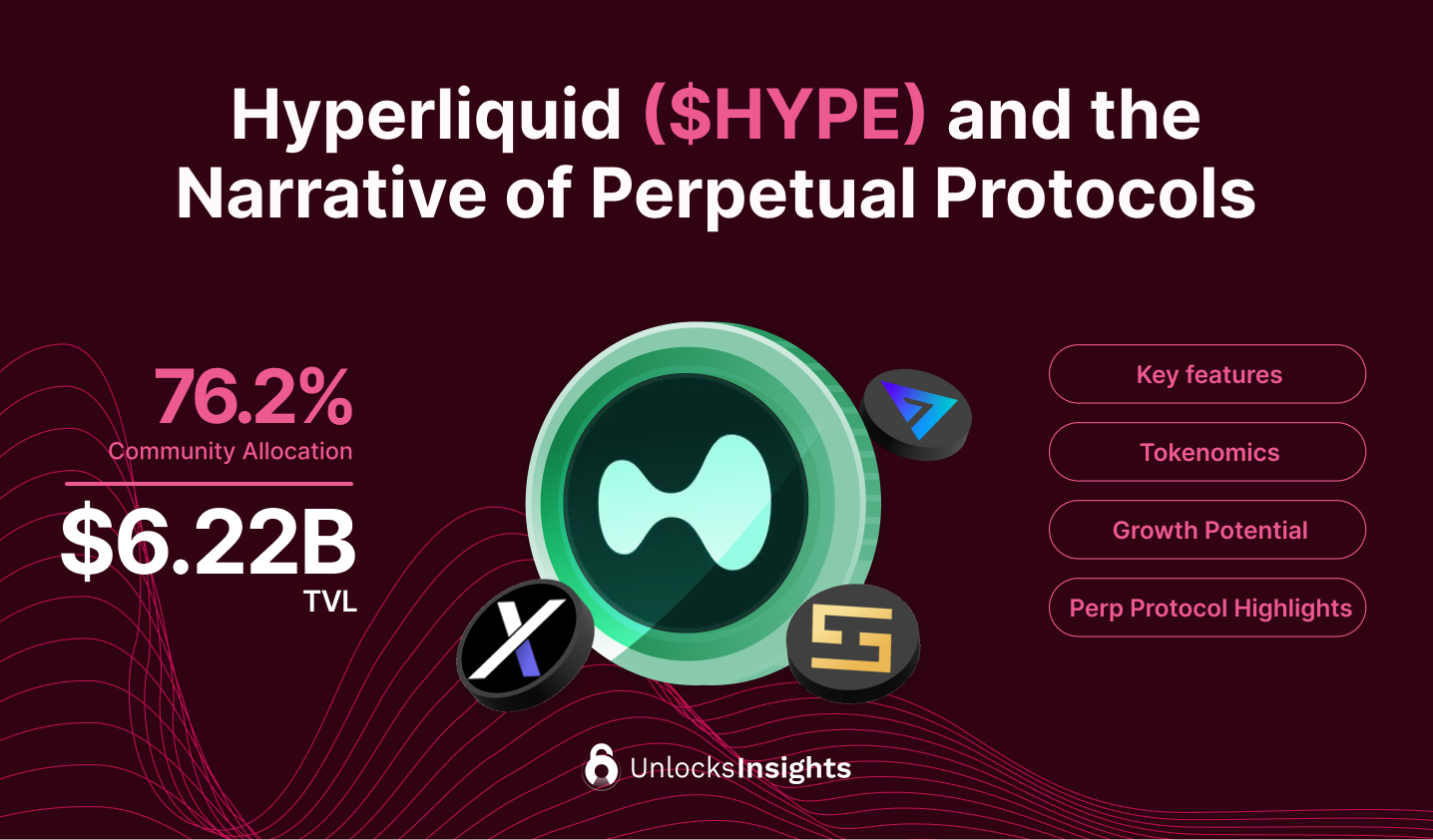
The cryptocurrency market is starting to show signs of a bullish trend, with MEMEs and AI driving much of the current attention. However, Hyperliquid’s recent Token Generation Event (TGE) has turned the spotlight on decentralized finance (DeFi). The project airdropped over one-third of its total token supply directly to the community, without involving exchanges or private investors, and has managed to keep its price steadily rising since launch.
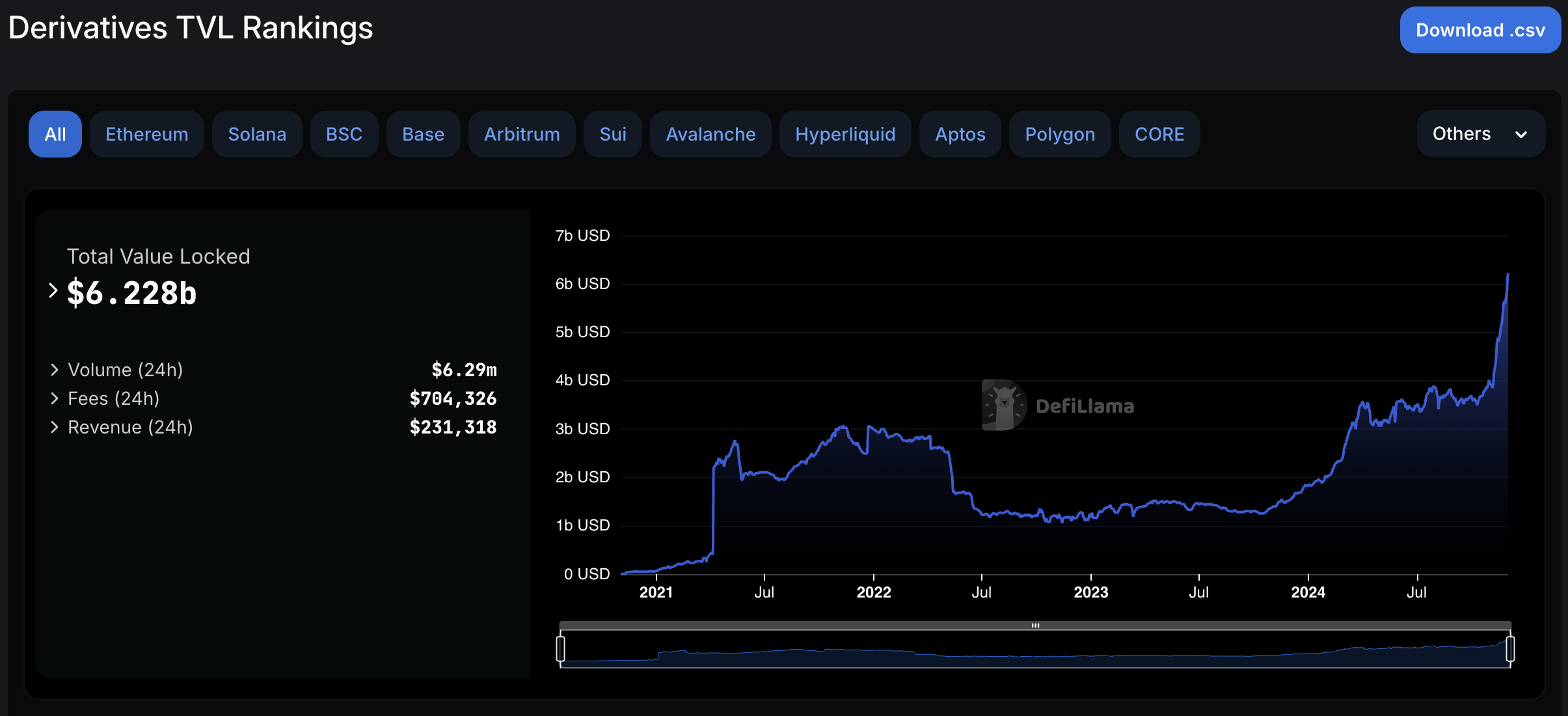
This success raises the possibility of a renewed market focus on DeFi, particularly decentralized perpetual protocols, in the same sector as Hyperliquid. Recent data from DefiLlama supports this potential trend, showing a notable increase in the total value locked (TVL) across derivative protocols. This growth highlights the increasing relevance of these platforms within the DeFi ecosystem.
In This Article
In this article, we explore:
- Hyperliquid Overview: Key features, tokenomics, and growth potential.
- Perpetual Protocol Highlights: A closer look at notable protocols in the perpetual sector, including dYdX (high market cap), GMX (mid market cap), and HMX (low market cap), selected for their significant metrics within their respective categories.
What is Hyperliquid?

Hyperliquid is a high-performance Layer 1 blockchain designed for a fully on-chain, open financial system. Its infrastructure combines the speed of centralized exchanges with the transparency and trustlessness of DeFi. It delivers fast, transparent, and scalable trading with block latencies under one second and throughput of up to 100,000 orders per second.
Tokenomics
Hyperliquid’s tokenomics emphasize community-driven growth. Its recent Token Generation Event (TGE) introduced the native token HYPE, with over one-third of the total supply airdropped directly to the community. Notably, there were no allocations for private investors or exchanges, ensuring that the project’s value is rooted in community participation.
Key highlights of the tokenomics include:
- Total Supply: 1,000,000,000 HYPE tokens.
- Allocation Breakdown:
- Future Emissions & Community Rewards: 38.888%
- Genesis Distribution: 31.0%
- Core Contributors: 23.8%
- Hyper Foundation Budget: 6.0%
- Community Grants: 0.3%
- HIP-2 Allocation: 0.012%
- Tokenomist’s Standard Allocation Breakdown:
- Community: 76.2%
- Founder/Team: 23.8%
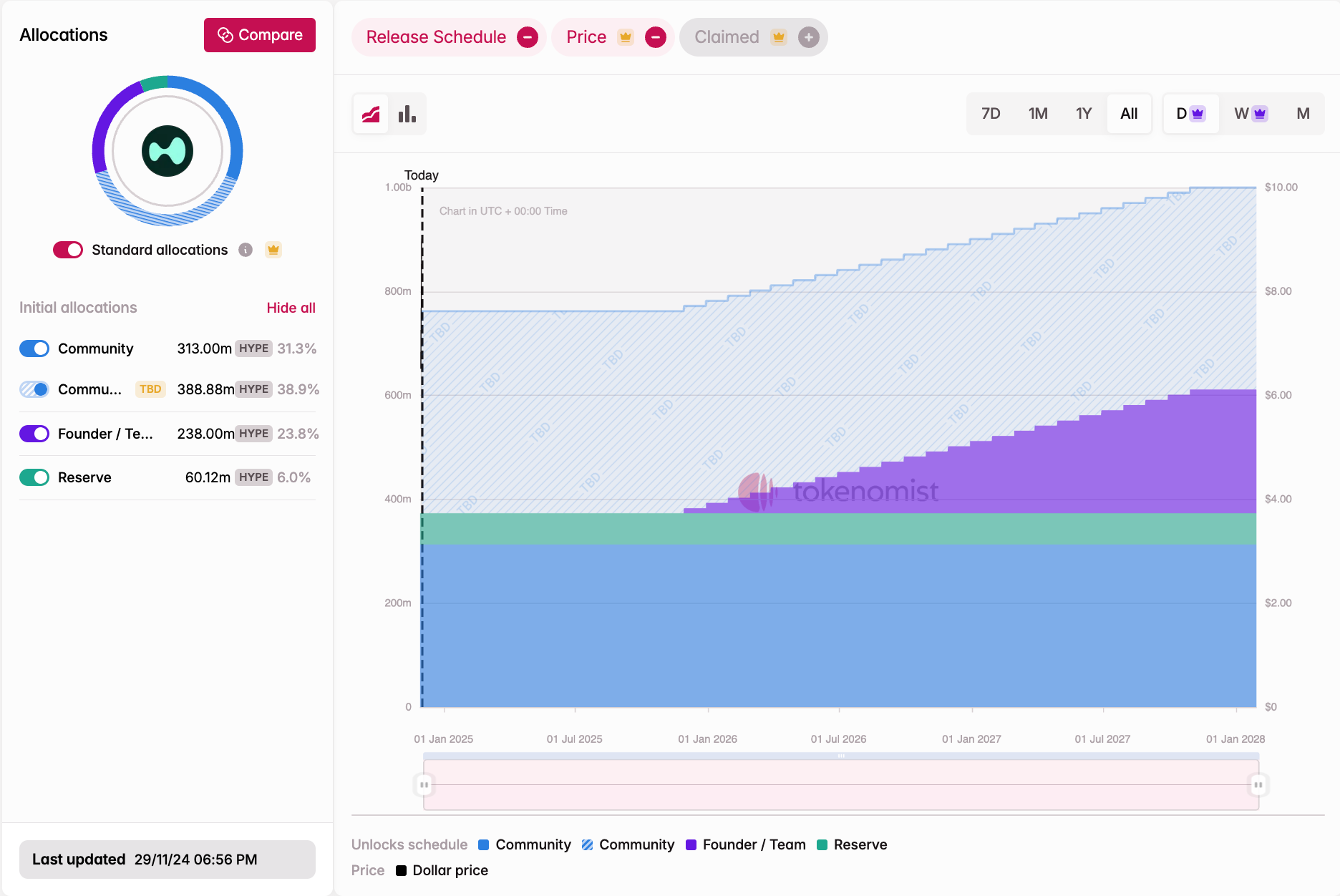
Supply Schedule
Hyperliquid’s supply schedule supports immediate liquidity with a high initial float while ensuring controlled emissions over time:
- Community Allocation: Over 30% of the total supply will be in circulation at launch through an airdrop. The remaining tokens will be emitted gradually over time. Some portions are also allocated for the foundation budget and grants to support ecosystem development at launch.
- Team Allocation: Locked for one year, followed by a gradual monthly unlock over two years, with full release by 2027–2028. The release schedule chart assumes a 2-year unlocking.
The high initial float promotes liquidity and active market participation from Day 1, setting it apart from the common trend of low float/high FDV tokens. The one-year post-genesis, when team tokens start unlocking, will be a critical event to observe for its potential impact on the market.
Bullish Catalysts
- High Initial Float: With over 30% of the total supply in circulation at launch—and no allocation for VCs or private investors—Hyperliquid stands apart from the trend of low-float, VC-backed tokens. Without any private entities holding pre-allocated tokens, anyone interested in acquiring HYPE beyond the airdrop must buy directly on the market. This approach has generated strong community support and positive sentiment, further boosting market confidence.
- Market Leadership:
Hyperliquid has shown impressive growth in user engagement and trading volume.
- Total Users: 190,000+
- Total Trading Volume: $300 billion+
Data from Dune Analytics reveals that Hyperliquid currently dominates the perpetual protocol market, leading with over 35% of trading volume among all perpetual protocols.
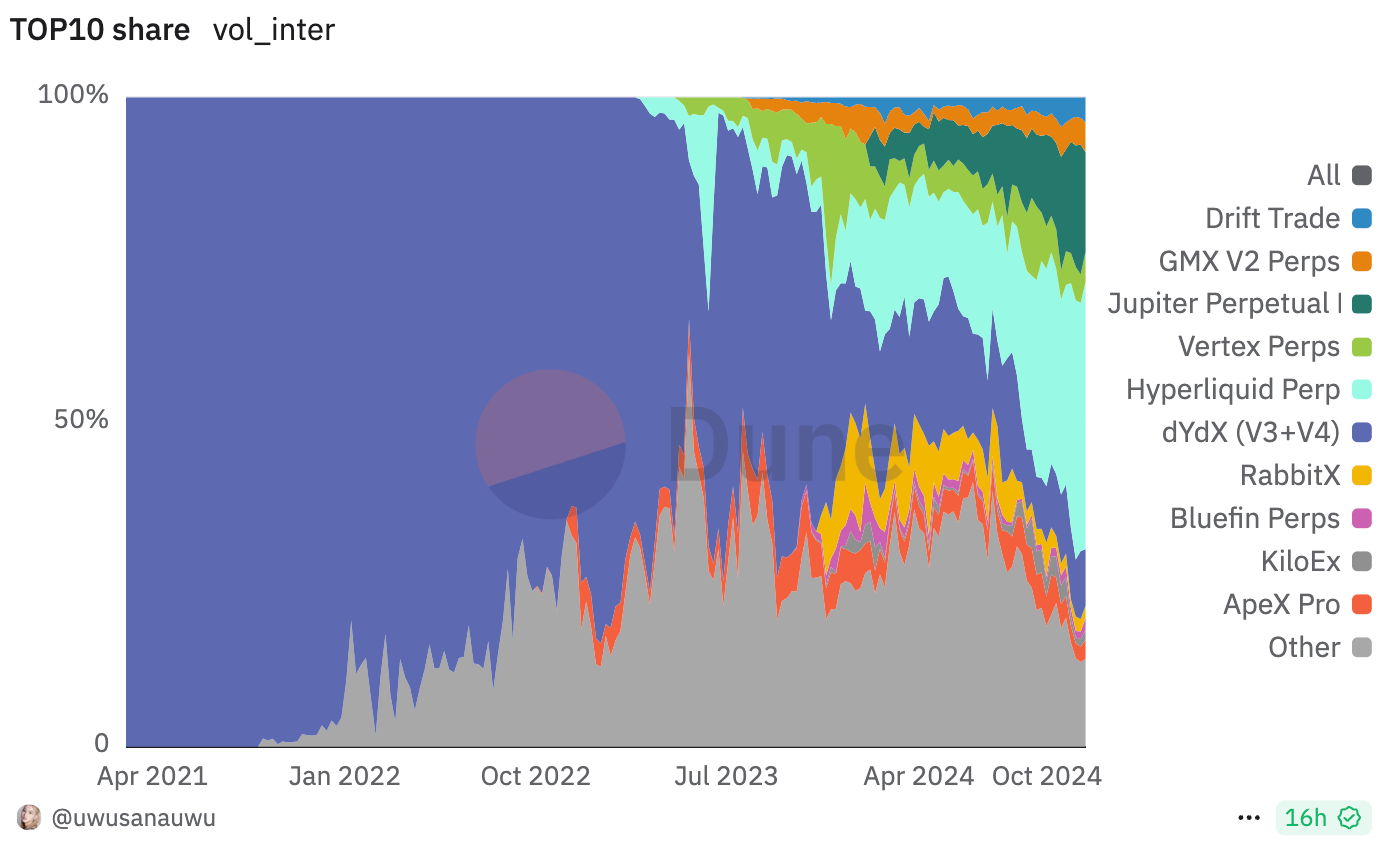
3. Ecosystem Growth: The HyperEVM introduces Ethereum compatibility, attracting over 30 projects, including dApps and GambleFi applications. Partnerships with Ethena and the integration of stablecoins like USDe further enhance utility, liquidity, and developer engagement.
These catalysts highlight Hyperliquid’s growth potential and its leadership in decentralized perpetual trading.
Exploring the Perpetual Protocol Landscape
Beyond Hyperliquid, several protocols are actively shaping the perpetual protocol sector, driving its evolution through adoption and innovation. In this section, we examine key players across market capitalization categories:
- dYdX (High Market Cap): An OG leader with a strong user base and a focus on the app-chain thesis.
- GMX (Mid Market Cap): A leader on Arbitrum, recognized for its unique liquidity model and steady growth.
- HMX (Low Market Cap): A protocol offering high-leverage trading with impressive performance-to-valuation metrics.
By analyzing their tokenomics and catalysts, we provide a comprehensive perspective on the decentralized perpetual protocol landscape.
1. dYdX: The OG Market Leader with an App Chain Vision
Overview
dYdX has established itself as a leading decentralized exchange (DEX) for perpetual trading, offering advanced features and a professional trading experience. Originally launched on Ethereum, the protocol transitioned to StarkWare in 2021 (v3) to overcome scalability issues caused by high gas fees. To achieve full decentralization, dYdX introduced its v4 iteration on the standalone dYdX chain, built using the Cosmos SDK, ensuring all components of the protocol are fully decentralized.
Tokenomics
The DYDX token launched on August 3, 2021, with its tokenomics evolving through team decisions and community governance. A notable event was the 1-year re-locking of investor and team tokens, which significantly boosted market confidence and drove prices higher.
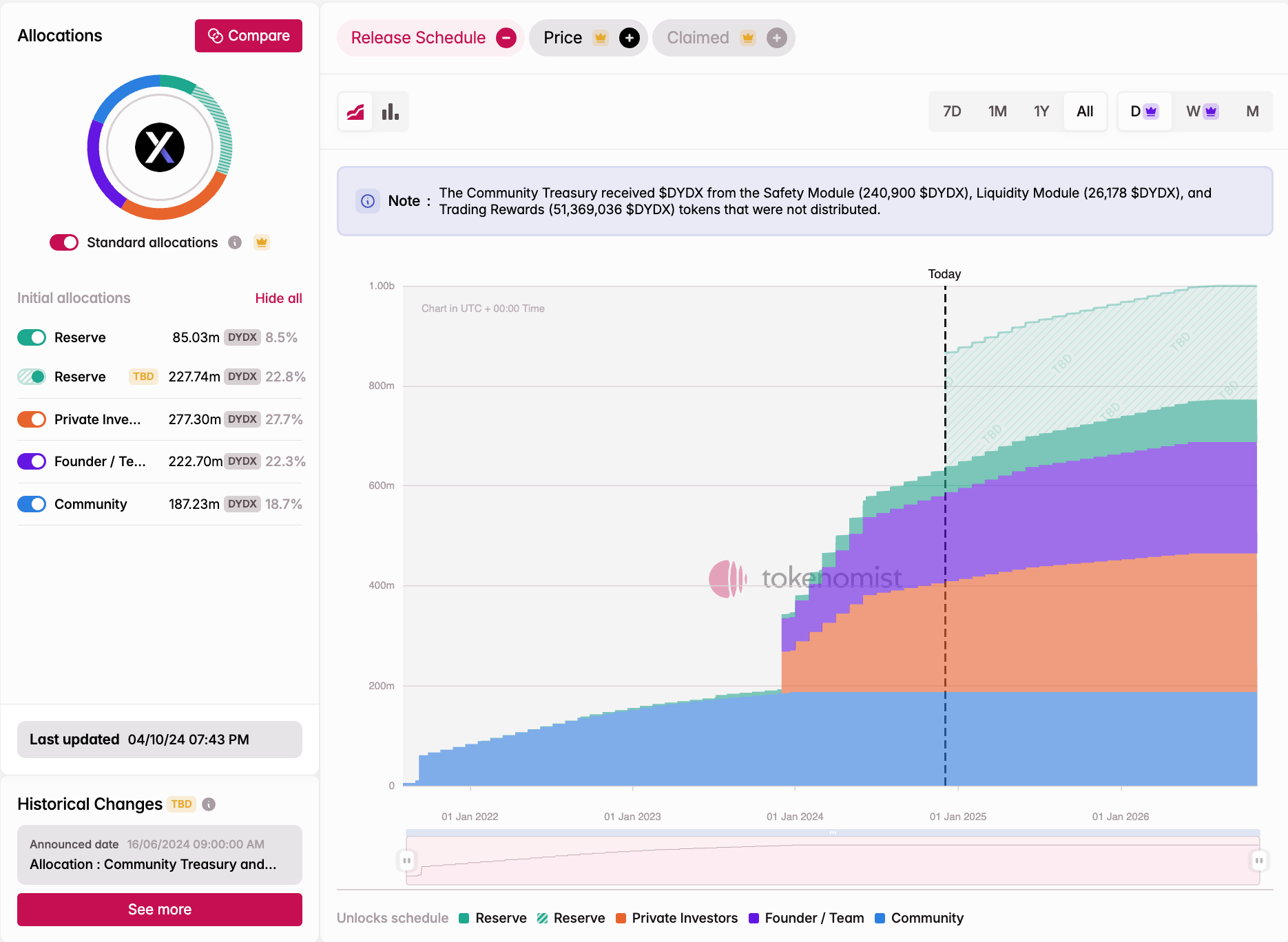
- Standard Allocation:
- Reserve: 31.3%
- Private Investors: 27.7%
- Founder/Team: 22.3%
- Community: 18.7%
- Supply Schedule:
- Team and investor tokens began unlocking this year with a significant cliff, followed by monthly unlocks until June 2026.
- Approximately 20% of the total supply remains unallocated, leaving room for future ecosystem incentives.
- Current token emissions are stagnant at ~80 million DYDX (<1% of total supply) per month, ensuring controlled supply growth.
Bullish Catalysts
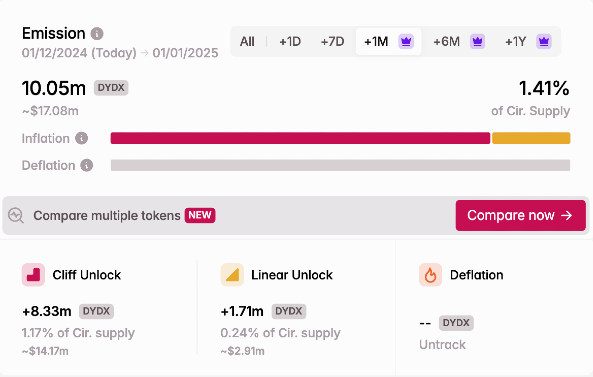
- Controlled Emissions: The steady monthly emission rate at ~1.4% of circulating supply ensures limited dilution, providing confidence for long-term holders.
- Flexible Allocation: Over 20% of unallocated tokens offer opportunities for future ecosystem incentives, enabling potential growth and adoption.
- dYdX Unlimited: The launch of dYdX Unlimited allows users to list and trade any market, expanding its appeal and creating more trading opportunities within the ecosystem.
dYdX Unlimited is finally here 🚀
— dYdX (@dYdX) November 19, 2024
Enter the Unlimited Era of instant market creation and automatic liquidity.
Get started today on DeFi's pro trading platform. pic.twitter.com/sW4ROv3ABG
2. GMX: A Midcap Leader on Arbitrum
Overview
GMX is a decentralized exchange (DEX) operating on Arbitrum and Avalanche, offering spot and perpetual futures trading with leverage of up to 100x. Its standout feature is the GLP multi-asset liquidity pool, which supports fees from market-making, swaps, and leverage trading, providing a sustainable and scalable liquidity model.
Tokenomics
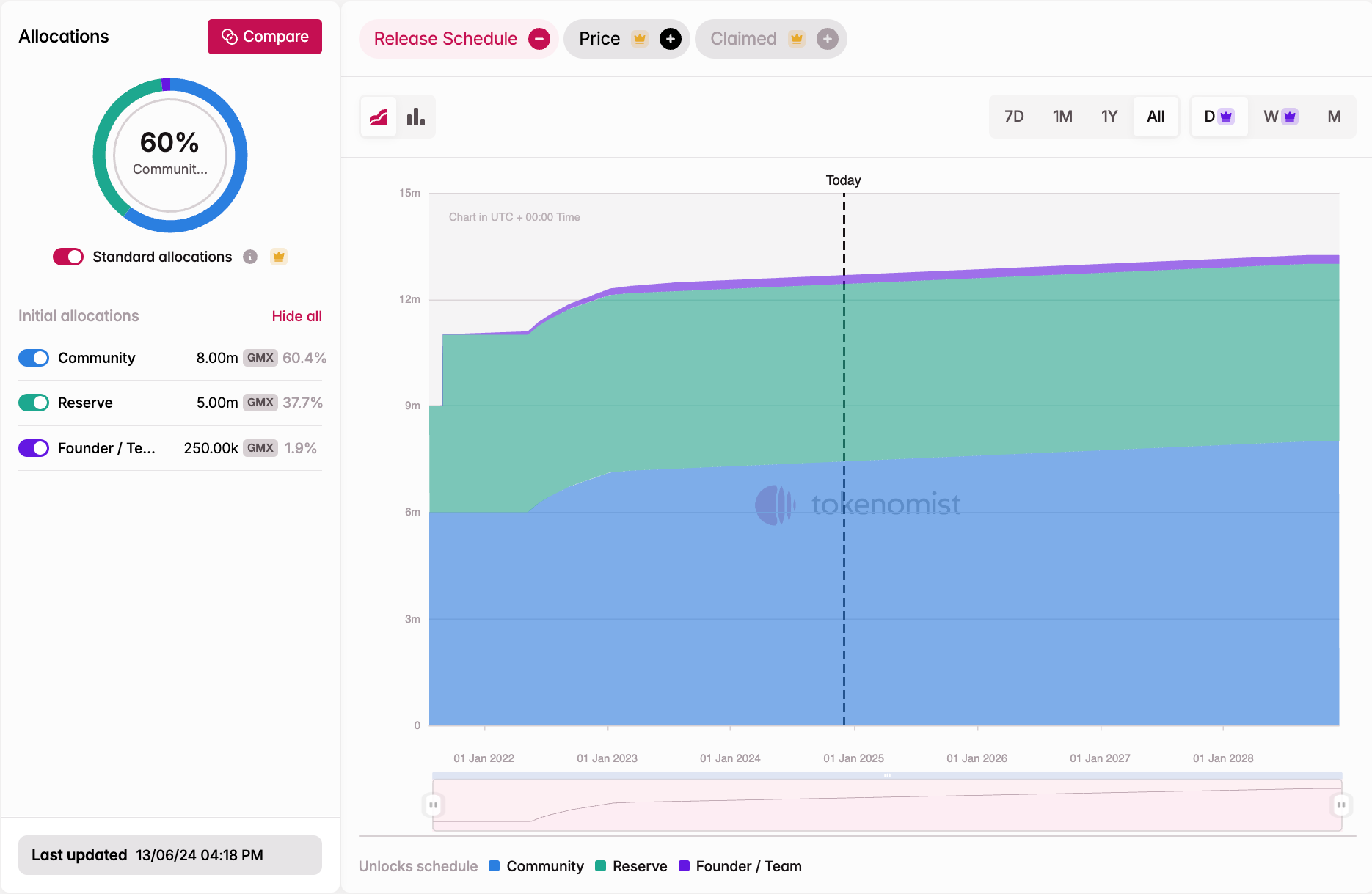
- Standard Allocation:
- Founder/Team: 1.9%
- Reserve: 37.7%
- Community: 60.4%
- Supply Schedule:
GMX launched in July 2021, transitioning from XVIX and Gambit tokens. Most of its token supply has already been unlocked, with remaining emissions primarily allocated as esGMX rewards under the community pool to incentivize protocol usage.
Bullish Catalysts
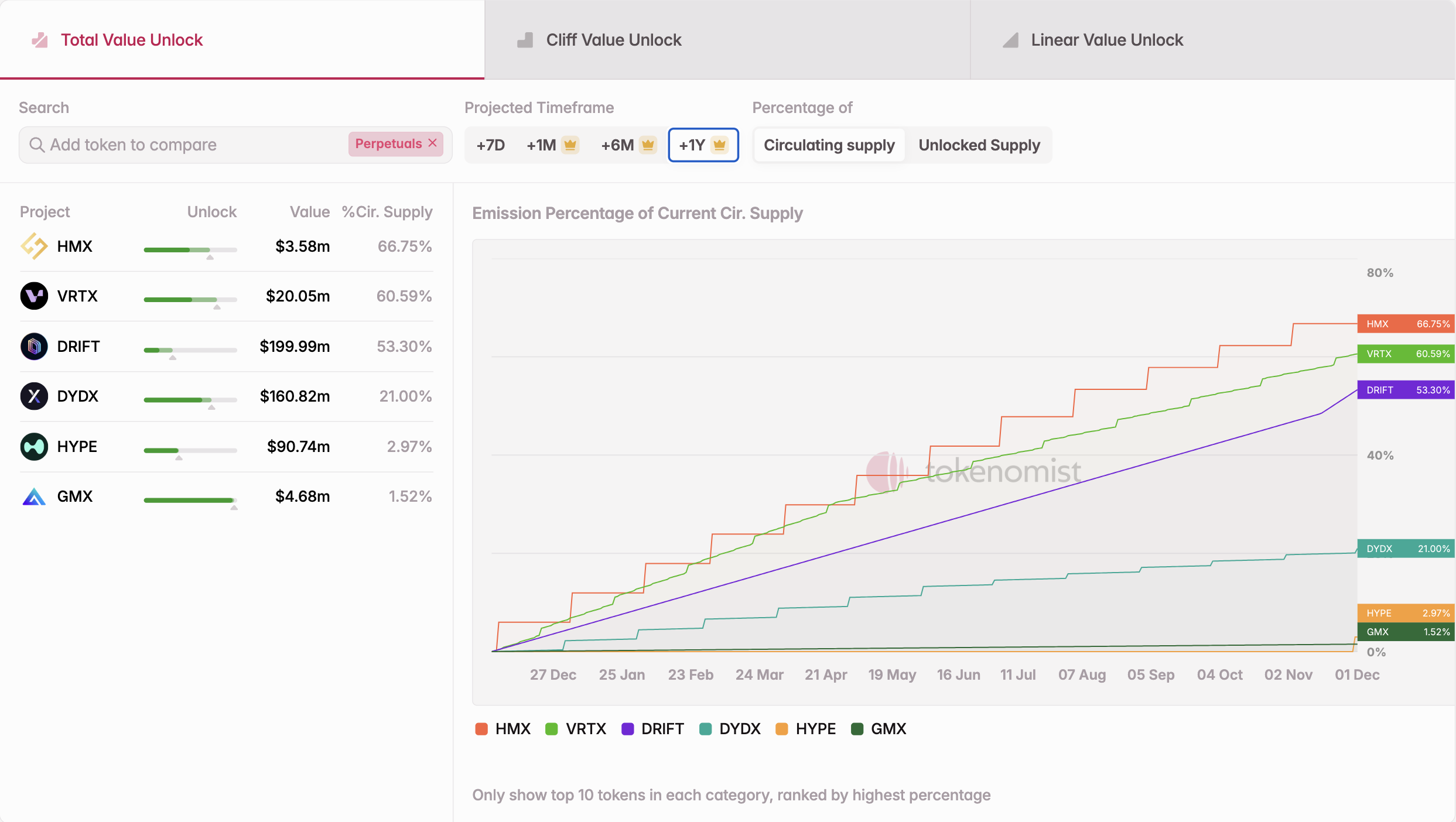
- Low Supply Emissions: With an annual emission rate of just 1.5%, GMX maintains one of the most conservative supply schedules in the perpetual protocol sector, minimizing inflation and preserving token value.
- Growth Across Key Metrics: GMX has shown strong growth recently, including a resurgence in TVL, a significant increase in open interest over the past three months, and a 130% growth in 30-day earnings, driven by elevated trading activity and robust fee generation.

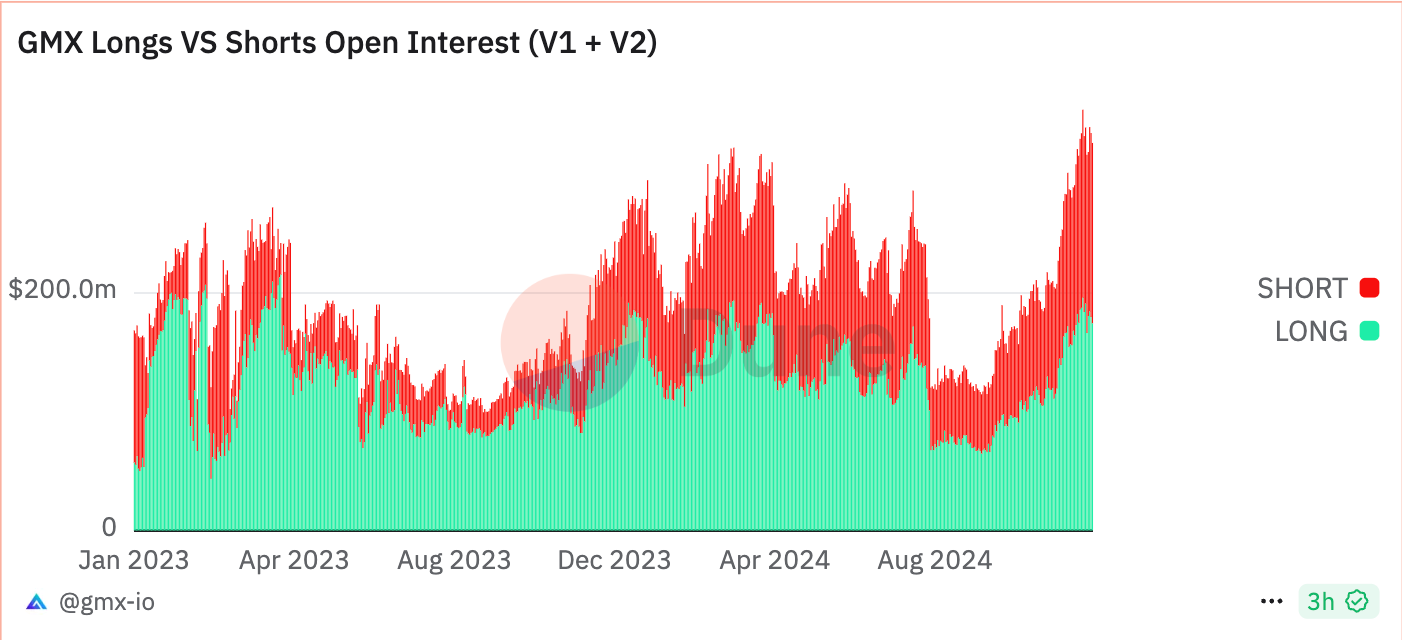
3. HMX: A Low-Cap Project with Strong Metrics
Overview:
HMX is a decentralized perpetual contract trading platform operating on Arbitrum, offering users the ability to trade cryptocurrencies and commodities with high leverage. It supports multi-asset collateral and full-margin trading, enhancing capital efficiency and user flexibility
Tokenomics
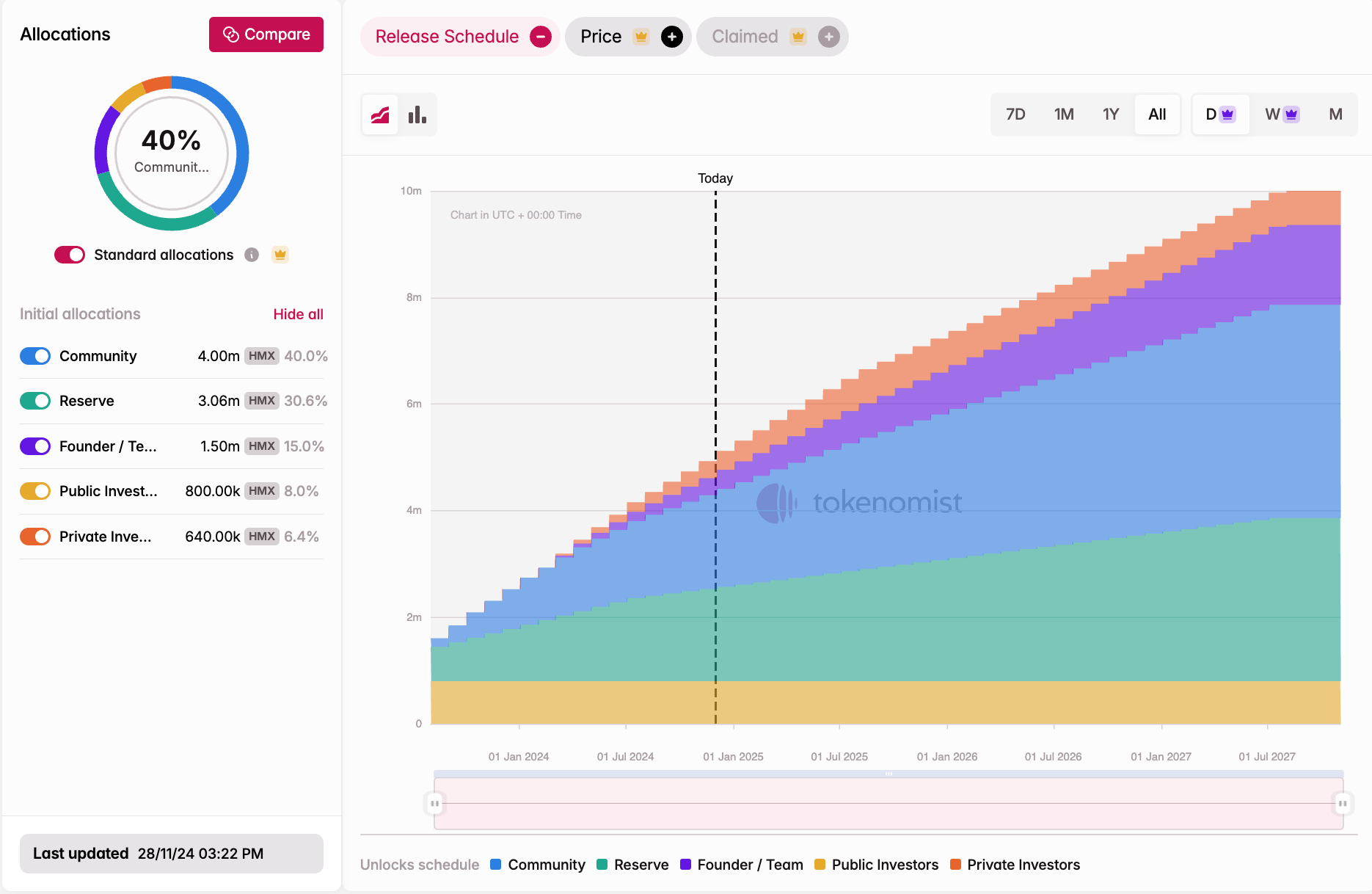
- Standard Allocation:
- Community: 40%
- Reserve: 30.6%
- Founder/Team: 15%
- Public Investors: 8%
- Private Investors: 6.4%
- Supply Schedule
HMX launched in August 2023 with its Token Generation Event (TGE) through public sale.- Team and Private Investors: 6-month cliff followed by a 42-month unlock for the team and 12 months for investors.
- Community Allocation: Allocated for platform incentives, following the detailed schedule in this sheet.
- Reserved Allocation: Used for ecosystem growth initiatives such as marketing, partnerships, and exchange listings. These tokens are not added directly to circulation upon unlocking and are utilized only when required.
Bullish Catalysts
- Strong Metrics in the Arbitrum Ecosystem:

- Growth Potential: HMX’s Mcap/TVL ratio is half that of GMX, with a P/F ratio of 0.39x (annual fees: $14M) and a market cap of just ~$5.5M, compared to GMX’s 3.4x (annual fees: $90M) and market cap exceeding $300M. With its strong fundamentals and much smaller valuation compared to GMX and dYdX ($1.2B), indicating tremendous room for growth.
- High Fees and Revenue: HMX ranks #2 in fees and revenue despite lower TVL, showcasing strong user engagement and platform efficiency.
- New Roadmap Initiatives:
HMX’s recently unveiled roadmap introduces major updates to enhance its ecosystem and competitiveness:- CLOB Model: Launching in Q1 2025, this model brings deeper liquidity, better price discovery, and advanced trading features.
- Improved Tokenomics: Includes token burns, governance-driven inflation, and an airdrop campaign to boost demand and user engagement.
- Rebranding: A new brand identity will reflect HMX’s transformation and position as an innovator in the perpetual DEX space.
Hey Dragons 🐉,
— HMX 🐉 (@HMXorg) November 28, 2024
The wait is over—here's our complete "Journey to One Piece" roadmap!! 📜
Dive into the details on our governance forum here 🌐: https://t.co/fr2ydHwZSo
We’re all ears for your thoughts and feedback! 👂
Quick Highlights:
1. Sustainable Tokenomics Unveiled 🌱
2.… pic.twitter.com/lwN5w6O5vo
Conclusion
The perpetual protocol sector is gaining momentum in DeFi, led by innovative platforms like Hyperliquid, dYdX, GMX, and HMX, each driving growth through unique features and strategies. As this sector evolves, it’s set to play a pivotal role in decentralized trading. To explore more about these and other tokens in this category, please visit: https://tokenomist.ai/categories/Derivatives
References



